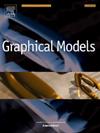3DMeshNet: A three-dimensional differential neural network for structured mesh generation
IF 2.2
4区 计算机科学
Q2 COMPUTER SCIENCE, SOFTWARE ENGINEERING
引用次数: 0
Abstract
Mesh generation is a crucial step in numerical simulations, significantly impacting simulation accuracy and efficiency. However, generating meshes remains time-consuming and requires expensive computational resources. In this paper, we propose a novel method, 3DMeshNet, for three-dimensional structured mesh generation. The method embeds the meshing-related differential equations into the loss function of neural networks, formulating the meshing task as an unsupervised optimization problem. It takes geometric points as input to learn the potential mapping between parametric and computational spaces. After suitable offline training, 3DMeshNet can efficiently output a three-dimensional structured mesh with a user-defined number of quadrilateral/hexahedral cells through the feed-forward neural prediction. To enhance training stability and accelerate convergence, we integrate loss function reweighting through weight adjustments and gradient projection alongside applying finite difference methods to streamline derivative computations in the loss. Experiments on different cases show that 3DMeshNet is robust and fast. It outperforms neural network-based methods and yields superior meshes compared to traditional mesh partitioning methods. 3DMeshNet significantly reduces training times by up to 85% compared to other neural network-based approaches and lowers meshing overhead by 4 to 8 times relative to traditional meshing methods.

3DMeshNet:用于结构化网格生成的三维微分神经网络
网格生成是数值仿真的关键步骤,对仿真精度和效率有重要影响。然而,生成网格仍然耗时且需要昂贵的计算资源。本文提出了一种新的三维结构网格生成方法3DMeshNet。该方法将网格划分相关的微分方程嵌入到神经网络的损失函数中,将网格划分任务转化为无监督优化问题。它以几何点作为输入来学习参数空间和计算空间之间的潜在映射。3DMeshNet经过适当的离线训练后,可以通过前馈神经预测高效地输出具有自定义数量的四边形/六面体单元的三维结构化网格。为了增强训练稳定性和加速收敛,我们通过权值调整和梯度投影来整合损失函数重加权,同时应用有限差分方法来简化损失中的导数计算。不同实例的实验表明,3DMeshNet具有鲁棒性和快速性。与传统的网格划分方法相比,它优于基于神经网络的方法,并产生更好的网格。与其他基于神经网络的方法相比,3DMeshNet显著减少了高达85%的训练时间,与传统的网格划分方法相比,将网格划分开销降低了4到8倍。
本文章由计算机程序翻译,如有差异,请以英文原文为准。
求助全文
约1分钟内获得全文
求助全文
来源期刊

Graphical Models
工程技术-计算机:软件工程
CiteScore
3.60
自引率
5.90%
发文量
15
审稿时长
47 days
期刊介绍:
Graphical Models is recognized internationally as a highly rated, top tier journal and is focused on the creation, geometric processing, animation, and visualization of graphical models and on their applications in engineering, science, culture, and entertainment. GMOD provides its readers with thoroughly reviewed and carefully selected papers that disseminate exciting innovations, that teach rigorous theoretical foundations, that propose robust and efficient solutions, or that describe ambitious systems or applications in a variety of topics.
We invite papers in five categories: research (contributions of novel theoretical or practical approaches or solutions), survey (opinionated views of the state-of-the-art and challenges in a specific topic), system (the architecture and implementation details of an innovative architecture for a complete system that supports model/animation design, acquisition, analysis, visualization?), application (description of a novel application of know techniques and evaluation of its impact), or lecture (an elegant and inspiring perspective on previously published results that clarifies them and teaches them in a new way).
GMOD offers its authors an accelerated review, feedback from experts in the field, immediate online publication of accepted papers, no restriction on color and length (when justified by the content) in the online version, and a broad promotion of published papers. A prestigious group of editors selected from among the premier international researchers in their fields oversees the review process.
 求助内容:
求助内容: 应助结果提醒方式:
应助结果提醒方式:


